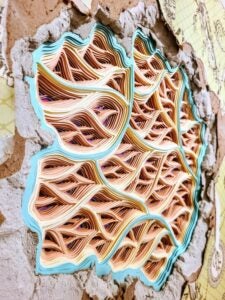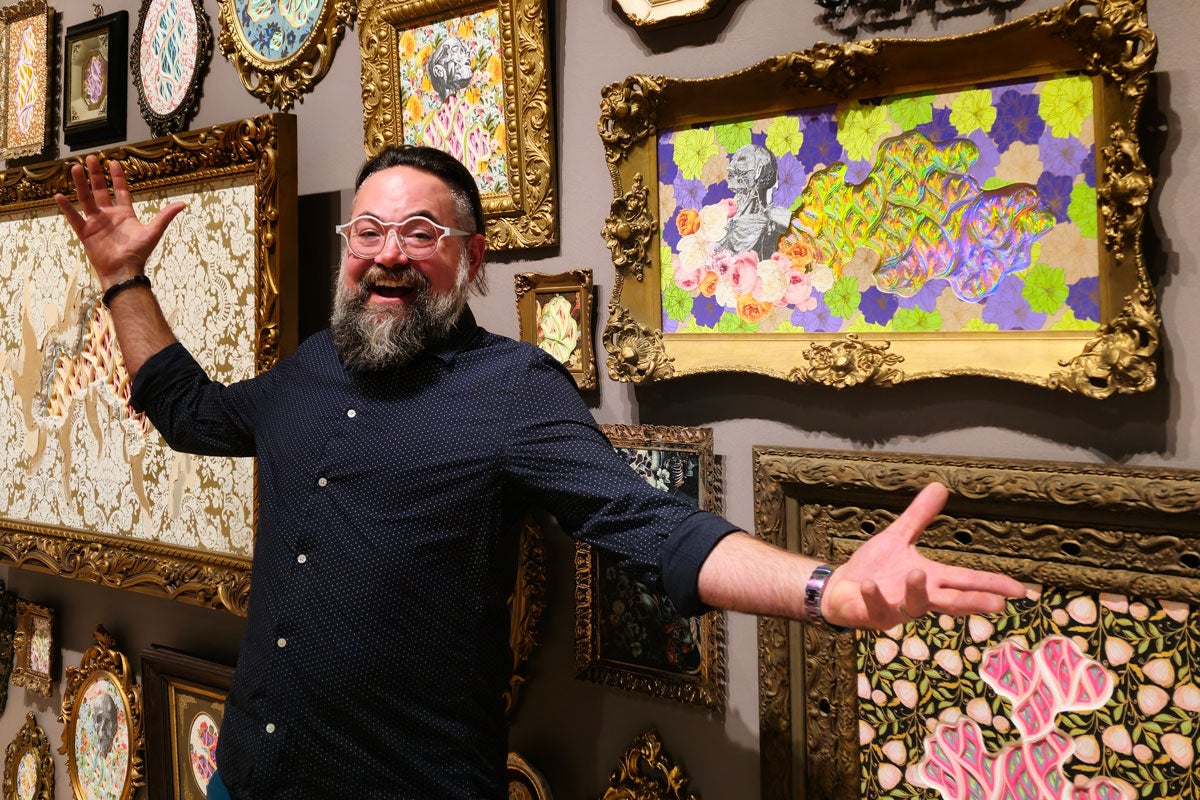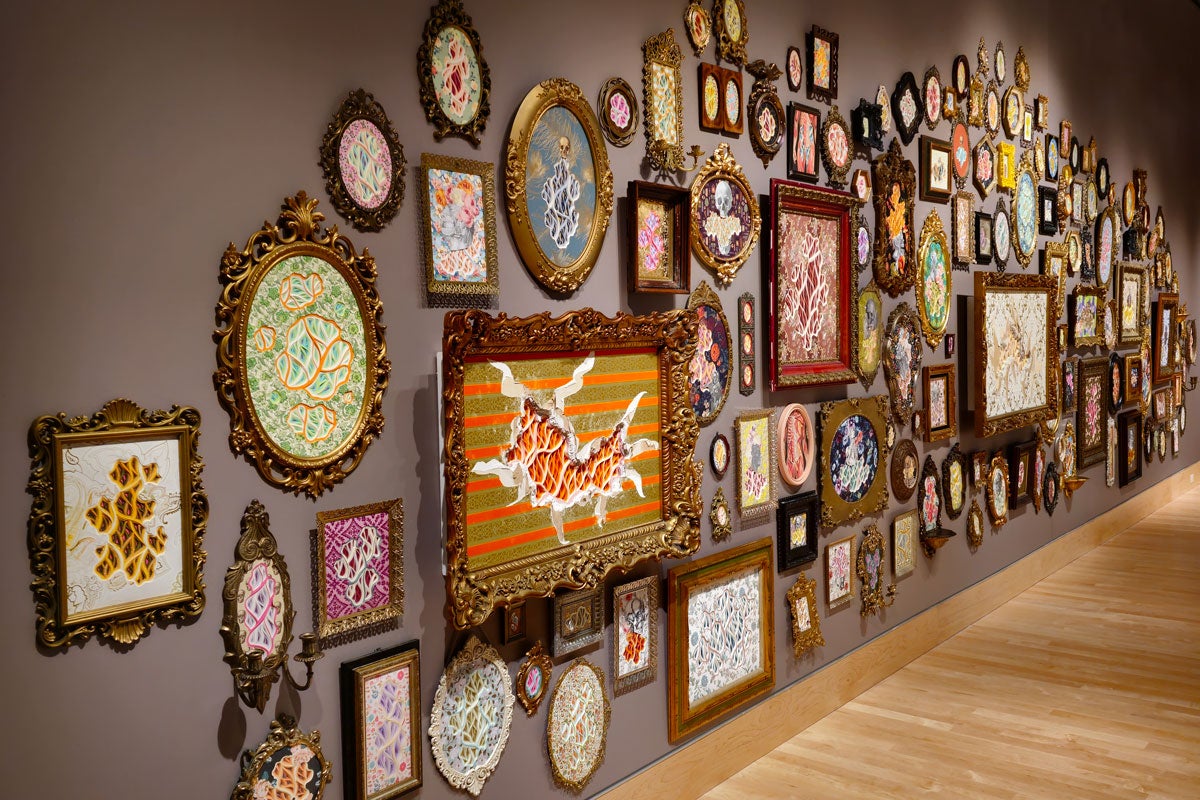This fall, hand-cut paper and collage artist Charles Clary will take over the UCF Art Gallery with Rococo salon-style walls, densely compacted with hundreds of frames, each containing a low-relief paper sculpture. The exhibition, titled Memento Morididdle, opens with a reception on Sept. 12 and runs through Oct. 11.
The UCF School of Visual Arts and Design opens each academic year by showcasing an external professional artist in the gallery. These exhibitions enrich the educational experience by exposing students to varying artistic practices, innovative techniques and industry insights directly from established artists and professionals. External artists contribute to the vibrancy of the program through workshops, lectures, exhibitions and collaborative projects, inspiring students to push boundaries and explore new artistic possibilities. It injects fresh perspectives, fosters creative dialogue and expands students’ artistic horizons. Their presence enhances learning and strengthens the College of Arts and Humanities’ reputation as a hub of creativity and excellence in visual arts education, preparing students to thrive in a dynamic artistic landscape.

“Clary’s work contains significant content of physical forms representing and openly processing trauma that viewers will engage with and relate to,” says Associate Lecturer and UCF Art Gallery Director Shannon Lindsey. “His incredible level of craftsmanship and tedious hand-cut paper works have a visceral effect where we can visually connect to his hand on the materials. The salon-style installation includes hundreds of individual works and commands your attention but also invites you to look closely at each hand-cut detail.”
The UCF Art Gallery hosts a call for exhibition proposals every two years, providing an opportunity for visual artists and curators to submit their proposals. Out of 145 submissions, Clary’s proposal was one of four selected by the UCF Art Gallery committee.
“We are passionate about bringing professional artists from outside of Central Florida to UCF to expose our university and greater Orlando community to artists they do not have access to regularly. I encourage the artists to embrace the unique physical space of the gallery and consider different layouts of their work,” Lindsey says. “In addition to benefiting gallery audiences, this experience provides an opportunity for visual artists to further experiment with their presentations and gain insight into how viewers experience and respond to the work. I frame these exhibitions as a meeting place where the professional artists, students, faculty, staff and greater community members can come together and have a shared impactful experience through visual art.”
In this Q&A, we interviewed Clary to learn more about the inspiration behind the exhibition.
Can you describe the inspiration behind the title Memento Morididdle? What themes or motifs are explored in this work?
I explore the ideas and history of “Memento Mori” and “Memento Vivere;” remember, you’ll die, so remember to live, combined with that of Victorian sitting rooms, where one gathers and exhibits their achievements.
In February of 2013, I lost both of my parents to smoking-related cancers. I began to think a lot about my mortality and my highly traumatic childhood. I see this body of work as a collection of traumas, healed over time yet still visible. I pay homage to how they have shaped me as a person and an artist.
What techniques or materials did you primarily use to create the installations? How do these choices contribute to the overall experience for viewers?
I am primarily a hand-cut paper and collage artist who uses found frames to encapsulate each paper sculpture. Paper is a unique material, common and every day, fragile yet resilient, much like the human psyche. Each frame is sourced from antique stores, thrift shops and flea markets. At some point, they held a cherished memory of a loved one or an experience but have been abandoned and forgotten. I seek to re-imbue them with new life and a new purpose.
Could you walk us through conceptualizing and creating one of the installations featured in the exhibition?
Each piece is unique and comes about in different ways. I work consistently, creating four to eight pieces a day. Thinking about the work that goes into a massive installation can become daunting and overwhelming. But dividing it up every day over a year allows me to build an enormous body of work and keep it fresh.
Everything starts with the found frame. How ornate is it? What history or story does it have to tell? How does the wear and tear show its age and life? Once the frame is chosen, the wallpaper will be selected. This can take some time because the paper needs to enhance and work with the chosen style of frame. Color layers are picked next, usually a combination of five going from light to dark. This step is the most exciting as it determines the mood of the work. I then mount the wallpaper to a base layer of illustration board or drywall. If it’s drywall, I will use a hammer and hand to distress the surface, creating the opening. If the surface is an illustration board, I map the opening in pencil and then use a Fiskars ergonomic craft knife to cut out the design. From there, it’s a lot of patience and intuition. I never have a roadmap when I begin. I start with the first layer of paper, laid underneath the initial opening, and then I trace out the shape slightly smaller than the opening. I use that first layer to inform the second, subdividing each subsequent layer until I run out of space between 15 and 20 layers. I then laminate each layer using archival clear glue or illustration board spacers between each layer to assemble the piece. They are then mounted from behind to complete the work.
How does your background or previous work influence the pieces in Memento Morididdle?
I’ve been cutting paper since 2007, but even then, I was a chromophile through and through. Color has always been central to my work. I think it’s because I had such a rough childhood and always saw things as drab, dark and hopeless. My work seeks to acknowledge those traumas and provide hope for those who have been through similar experiences. These “beautifully scarifications” remind us that wounds heal, life moves forward, and if we were brave enough, so could we.

Are there specific messages or narratives you hope viewers take away from experiencing your installations?
I want the viewer to come away with a sense of awe and hopefulness. These installations are meant to be overwhelming and all-encompassing, as are the emotions they are mimicking. At the same time, I want the viewer to question the modality of creation. From afar, my work looks laser cut, but once they get up close and personal, they realize the work’s subtle imperfections and handmade quality. In a sense, it’s like viewing the world around us. Everyone at a glance looks as if they know what they’re doing and put together; it’s only when we get close that we realize how imperfect we really are and that we are all just trying to get through life the best way we know how.
What challenges or rewards did you encounter while preparing for this exhibition?
I think the constant challenge is not getting stuck in the traumas of the past. My parents passed away 10 years ago, even though it feels like yesterday. I must remind myself that this work isn’t about the sadness and the grief; it’s about growth, healing, forgiveness and hope to enjoy the life I’ve built for myself. The reward is how it touches so many viewers. Once they uncover the narrative behind the work, their collective traumas start to seep out, and there is a palpable connection.
Can you discuss any references that influenced the creation of your artworks in this exhibition?
I’m always looking at everything. When my parents got sick, I was fascinated with the mesmerizing electron microscope images of cancer cells. It was elegant in its construction but deadly in its actuality. How could something so beautiful be so destructive? I read [Charlotte Perkins Gilman’s] The Yellow Wallpaper and was overwhelmed with the narrative and symbolism. I’m very much engaged with contemporary art. I am fascinated by artists such as Sarah Sze, Julie Mehretu, Daniel Zeller, Mars-1, Swoon, Felix Gonzalez–Torres, Pip and Pop, Mia Pearlman and so many others.
How does your work challenge traditional notions of art or exhibition spaces? What effect do you aim to achieve in your installations?
I like to think of my work as organic and ever-changing. You’ll never see one of my installations the same way twice. It grows and morphs to fit whatever space is offered for its gestation. Paper is a material that all artists have a unique connection to, whether they use it as a substrate for wet or dry media, as a collage element, as a sculptural element, etc. To use it as a primary medium challenges the viewer’s notion of what can be considered a “fine art” medium. I hope my installations provide an access point to the arts by using humble everyday material to create fantastical experiences.
Are there any specific stories or anecdotes behind the creation of certain pieces in Memento Morididdle that you’d like to share?
There are over 380 works in this installation, and everyone tells a story, specific or otherwise. Every piece reminds me of my late mother and father, the silent struggles they were forced to endure, how they affected me as a child, and how my reactions to those situations molded me into the person I am today. It is a collection of memories and non-memories that speaks to resilience and our ability to survive.
How does your journey or experiences influence the conceptualization and execution of your art installations?
Without my journey, I don’t think this work would be possible. I often get asked if I could change my trauma. Would I? My rational side says, of course, but without my past, I wouldn’t have my present or future. This resonates within the work and the process of its creation. This, in turn, imbues it with life, allowing it to live on its own and in the minds of my viewers.
Visit Memento Morididdle by Charles Clary at the UCF Art Gallery from Sept. 12 to Oct. 11. Join us for the opening reception on Sept.12 and attend the artist talk during the closing reception on Oct. 11 for more insights into Clary’s work.




